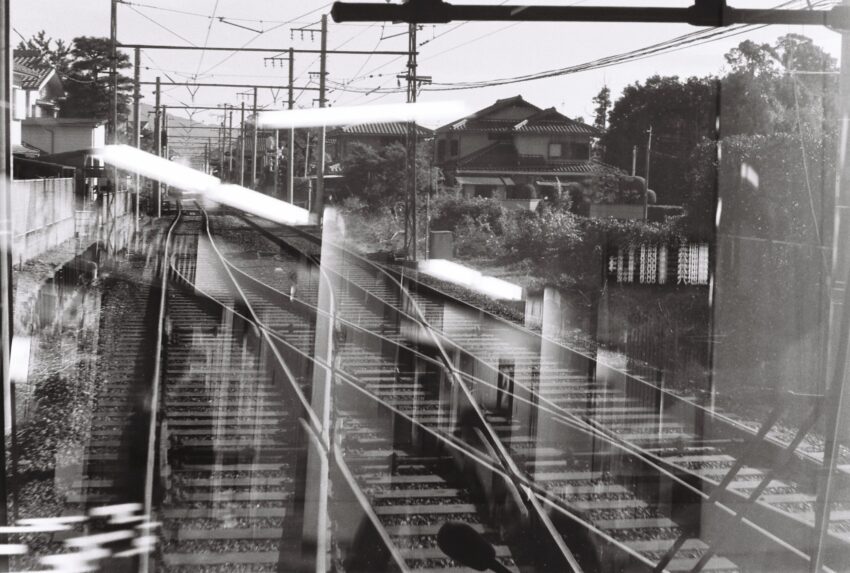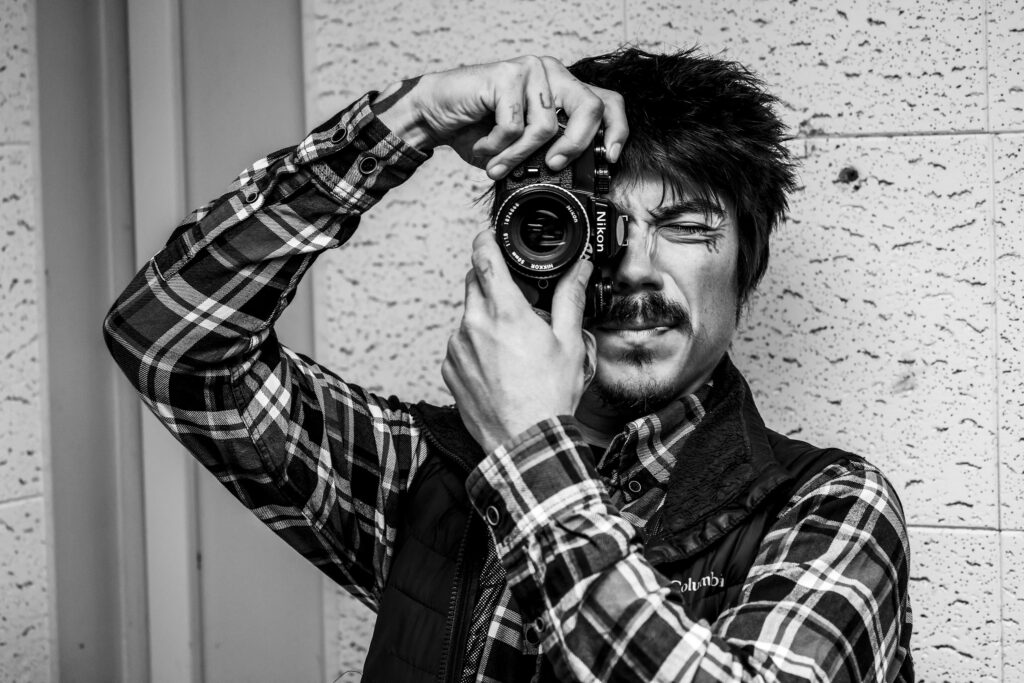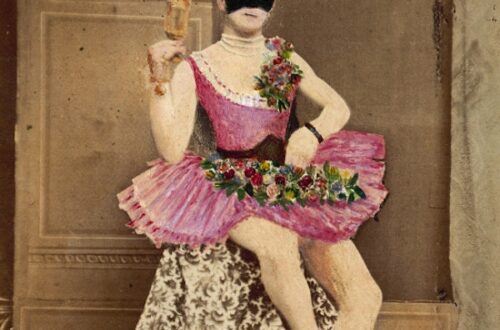
There and Back and Back Again Again
photo by Tony Wallin-Soto
by George Choundas
You walk briskly to catch the train. Couple of blocks to go. Running late. Even chances you’ll make it. Then you see something fifty yards ahead, darting into your path from a side street. It’s another commuter, also running late. He’s looking at his wristwatch and jittery. Like you, he vibrates as much he moves, clearly fraught with decisional anguish, debating whether to break into a sprint. Then he turns and catches sight of you. In a moment’s glance, he appraises. He notes you’re walking and not running, and presumably gathers up indications of credibility—who knows, maybe the fact you’re carrying a laptop bag, maybe the fact you’ve got pants on—and then he relaxes his face, turns forward again, and settles into a calm and contented lope. You think: Shame on you for depending on me.
* * *
The walk each morning from home to train station comprises three legs.
The first leg starts at your front walk, runs past Bedford Road School, and ends at the intersection where Doris the Crossing Guard rules with kind iron. She is exceptional. She has a knowledge of that precise level of savagery with which she must shout-scold speeding drivers to deter them in future. She has a knack for choosing that demonstrably fungible yet seemingly meaningful thing to say in greeting to any given passerby without risking glibness. The bulk of people like this have been scouted by political operatives and deposited into positions of high office. Doris the Crossing Guard should be Deputy Secretary of Commerce. Instead, she is a crossing guard who moonlights as a stock person at ShopRite. She is exactly as cheerful and bluff at ShopRite as she is at her intersection. Shifting from one job to the other, she goes from giving orders to taking them, from being the center of attention to plugging away at the periphery.
She shows not the slightest hint of defeat or resignation at this radical demotion from center and above to below and behind. ShopRite should find Doris when she’s immersed in stock duty, wait until she’s not looking, put a needle in her arm, extract a blood sample, send it across the parking lot to CVS for analysis, replicate the biochemical profile in one of the labs inside the bagel place next door to the CVS because the bagels there are so intensely horrific they could not be formed by other than a chemical process, and then have Doris stock the result as a mood/judgment/life-enhancer in ShopRite’s drug-and-toiletry section. You would spend your 401(k) for a supply.
On the next leg sits the house fenced by six-foot hedges. You can’t really see much house behind those hedges. They’re too tall, too dense. They so conspicuously imply the concealment of exotic transgressions that they confirm the people inside must prefer that passersby think the worst rather than know the truth, which in turn confirms they are running a papier-maché dolphin sex ring. You once saw a boy walk out of that house with a book bag. Implausibly, you could not see his eyes because three-inch bangs walled off the top part of his face—like a hedge. It seems the adage is wrong. People look like their homes, not their pets.
This second leg is where you used to see the young man who walks with a messenger bag down at his waist, with his floppy lanky body, who looked to you like a kind boy but who one day you saw at the other end of the commute, at Grand Central, on a sultry Thursday or Friday afternoon waiting for a train to arrive so that he could board it, staring at passing women, openly, challengingly, with wolf eyes. Your resentment was one part toward him for being such a piece of shit and two parts toward yourself for proving that you’re getting old because aren’t old people always presuming that all young people are kind and nice and overlooking entirely the vice and corruption that show obvious to anyone under thirty? You never see Wolfboy anymore because now he follows a shortcut behind the former community center that takes him to the other end of the train station in what you imagine he thinks is an ingenious way. He conquers distance like he imagines he’s conquering women, the asshead.
The third leg is straight downhill. It is also the key to your retiring at age 55. All you need is to start renting skateboards at the top of the hill just two blocks east of the train station. For every morning train, at least two poor fools run down this hill to catch it. If these knuckleheads could just hop on a skateboard in front of the Catholic church they’d make it, no problem. They’d gladly pay gouging amounts—fifty dollars, maybe—if they had an important morning meeting. You’d be content with twenty. Two suckers per train, eight trains per morning, you’re pulling in three hundred and twenty a day. That’s eighty thousand a year. Working only weekdays, no less, 6 a.m. to 10 a.m. This means two things. First, your effective annual salary, adjusted for time, would be that of a federal judge. Second, you’d be free the rest of the day to dance jigs or study frogs or translate Horace.
Sometimes you divert midway through this third leg by turning right on Wheeler Avenue, which runs parallel to and a block short of the train tracks, and through the train station proper, and onto the north end of the train platform. This street is the jewel box of Pleasantville commerce. Four restaurants, three delis, two jewelry stores and two barbershops, a drug store and a phone store and an eyeglass store. It is early, and so half the shopworkers have not yet arrived, and the other half, freshly dislocated and in denial, gaze at the outdoors. They stare through windows while standing inside their shops, or they stand in the doorways of their shops, or they stand outside the fronts of their shops. Were you to ask them why, they’d invoke the fact of limited business at that early hour, and then compensate for their vulnerable looks with a take- charge line like “Where is everybody? I’m running a business here.”
But were you to dispense with asking and just watch their solemn gazing faces, you’d understand that they stand there—tender, stunned, thrust into haphazard dealings just minutes after having sprawled and lolled in their warm beds—to survey, for hints of an explanation, this world that has so betrayed them.
* * *
In front of the grade school, square to the street, sits a sign. It reads “Bedford Road School.” Made of brick and concrete, it is battlement-massive: six feet high, eight feet long, thick enough front-to-back that a grown man could comfortably sleep on its top edge. Strolling families often stop so that the fathers can avenge the numberless dinosaur stickers they’ve found on their windows and cars and eyeglasses by lifting their children onto that shelf for a few moments of mutually delicious terror. The thrill is compounded by the sign’s acoustic properties. Something about its shape deepens and amplifies incoming sound waves before sending them back out.
Really the sign is for the parents, not the children. It’s an assimilation machine. Many of the younger families hail from New York City. If they miss the crowds and bustle, they can go to the sign, sit down and lean themselves against it, close their eyes, and listen. In front of the sign, the passing traffic blares twice as loud, rumbles twice as long. Instantly they’re transported to the corner of Lexington and 54th.
* * *
From racing repeatedly to the train station against rigid time parameters you have learned secrets. To goose your speed with only slightly more effort, you know to change the rhythm in your head. Most people’s default is a 2/1 rhythm—ONE-TWO, ONE-TWO. Probably because they have two legs. This is clunky, labored. It emphasizes the left-right-left-right lateral quality of walking, ruining forward progress with sideways motion. Instead, you think a 3/1 rhythm.
ONE-two-three, ONE-two-three. You time your breathing accordingly, inhaling on ONE, exhaling on the next ONE. A three-rhythm imparts instant fluidity. Ask any waltz dancer, any composer of mazurkas.
Even better is a six rhythm. ONE-two-three-four-five-six, ONE-two-three-four-five-six.
This is just a three-rhythm with less time to waste.
The guy ahead of you has not noticed your seamless shift into a six-beat trot. Still he toddles in the oblivious calm of false reassurance.
* * *
Your house is on the same street—and the same side of the street—as the train station. Every weekday morning you walk the same stretch of sidewalk downhill from home to train. Every weekday afternoon you walk the same stretch uphill, in the other direction, from train to home. Often while walking this stretch of sidewalk you have the same four-part thought:
- If everything goes smoothly, you will likely never move to a different town.
- If you’re lucky, you will always have a job in the city.
- Thus, if fortune smiles, things will remain largely as they are.
The best you can hope for, therefore, is that you will walk this same stretch of sidewalk again and again until you die. Sometimes this is too much.
Sometimes you cross the street—even if it means you just have to cross back later. So you can walk another stretch of sidewalk instead.
* * *
Walking to the train station one morning, you look across Bedford Road and see a kid on a bicycle, standing on her pedals, struggling to go in the opposite direction—away from the station—and thus up Bedford Road’s incline. She works and she works, but she barely moves.
It’s a wonder she does not fall over. She must be moving at exactly that minimum incremental rate necessary to stay upright. All the while she looks intent and matter of fact and game enough. She shows no frustration or dismay, not even weariness. Far from upset, she seems cheerful. This is an omen of some kind, but you’re not sure of what. Is it descriptive, portending that you face an equally futile day? Is it prescriptive, suggesting you emulate this fine young woman and persevere with sunniness and infinite will? Is it metascriptive, reminding you that even something so arbitrary, instantiated, as a kid on a bike in the wrong gear contains a fund of verities?
* * *
Bedford Road runs east-west. The way to the train from your house is west. Snow typically blows from the west. This means on days when you don’t especially want to go to work because it’s snowing, the snow laughs in your face, if we can agree that blowing is the same as laughing. It laughs sloppy and frigid, not merely faceward but downward, slicing at an angle. It laughs down your neck, desperate to chuckle against your sternum. Were you to open your mouth, your gullet would fill like a stocking with two states of matter. Rare is the meticulous torturer, the obsessive-compulsive bully. Generally these don’t exist. Generally nature abhors an excess and scruples to endow the same entity with both heedless malice and mindful precision. Snow is the privileged exception. It cavorts with impunity like the principal’s son. Every flake that snickers against your face says, What are you going to do about it? But what are you going to do about it?
* * *
The train station and the school are in opposite directions along Bedford Road. Each morning, you plunge like a lost sturgeon through shoals of kids and parents. They stream around you, dragging a vivid kelp of backpacks and hoodies and jackets. You see the chattering kids and the brooding kids, the carefree kids and the scrutinizing kids and the kids who yell when they talk. Occasionally you have the luck of observing kids without their parents and then, later in the school year, the same kids with their parents. It’s then that you experience the inexplicable pleasure—at once predictable and miraculous—of seeing the parents of the chattering kids chatter and of the scrutinizing kids scrutinize and of the yellers yell.
There’s one kid you look forward to seeing the most. He walks slowly, wonderingly, fascinated by his immediate surroundings. School is his destination in only the most technical sense. One might say he ambles, but one would be wrong. Ambling suggests mostly advancing movement, with dilatory limbs and an easy, slung-back head. Start with ambling, subtract any residual drive and discipline, add the bumbling innocence of somebody whose fondest wish is to have a sleepover with rainbows, and one approaches this kid’s mode. Alternatively, one might imagine the tentative tortoise pace of a person scanning the ground for a dropped quarter, but instead of looking down, the person gazes up, at the trees, the houses, the sky. The kid’s mouth either hangs open or moves absently, as if he’s singing himself a song about sleepy, sleepy rainbows. Most conspicuous about him is his right arm, which swings a lunch box in wide careless circles. The swinging lunch box is too much, in your opinion. The swinging lunch box threatens to transform him from a sweet kid overwhelmed by the world to a caricature of a child actor who’s just received performance notes from a first-time director about how to play a sweet kid overwhelmed by the world.
The kid has a chronic case of wonderstruck. A kid like that gets either worshipped or abused. That can change, from one to the other, but rarely with the same set of peers. Usually it’s one or the other until the kid changes schools, and then the sociocultural dice are rolled with an entirely different group of spazzes and shitheads who get to decide whether their fresh peer merits fascination or exile.
You so hope Wonderstruck gets the benefit of the doubt.
You’ve never seen him with a parent. It occurs to you that, if he had had a parent alongside, you may not have noticed him, as innumerable and unremarkable are the children who cede all accountability when in the company of a parent.
The only bad thing: you encounter this kid in early morning. Given that seeing him is often the best part of your day outside your home, it puts an unfair threshold on the rest of what transpires, makes the rest of the day grayer, plainer.
You used to see Wonderstruck all the time. Recently not so much. Last year you and he passed each other a couple of times. It’s occurred to you on occasion that Wonderstruck—like your own children’s innocence, like the things we call our lives—can’t last forever. He’ll persist, God willing, but different, older, forth-minded, not how you’ve come to know him. Because he will change. One day you’ll see him, and he’ll be walking briskly, making and breaking crisp eye contact like the senior trader on a derivatives desk, and the world will no longer hold much mystery for him.
It’s September. Today you see him for the first time this school year. It’s been months. You see him and you brace. You prepare for the changes, for the possibility that, while the child may be doing just fine, Wonderstruck is dead.
He’s slightly taller. His hair seems darker. That may be because it’s peeking from under a bright blue, ski-style winter hat. You thought he’d be different. He is. Used to be he gazed at the sky. Now, with a hat on—you’d never seen him with a hat before—he looks very much like he is gazing at the front of his own hat and trying to read what it says there, and failing, and not just because there is nothing written on that hat, but also because eyes don’t work like that.
You didn’t think it got more luffheaded and dreamsent than swinging a lunch box in an arc. Oh, were you wrong. Like Orpheus and Gideon, like the less cherubic angels needy of attention, he was carrying a trumpet. To be clear, he was gazing at his own forehead while swinging a trumpet case. Thank you, Wonderstruck, you think. Thank you, for hardly changing.
* * *
You turn and crane when you hear honking because you want to see the fury and the fight. All you see is a motorist slowing to talk to a pedestrian, both of them all smiles, for chatting before the motorist continues on to Key Food and the pedestrian to an arts-and-crafts festival planning committee meeting, and all the other motorists driving calmly around to allow this lucky pair their impromptu congress, the gentle arcs inscribed by their slow passage as close to a caress as can be achieved by an object three thousand times the mass of a hand.
* * *
You ride the same train every time. Every morning the train passes Pleasantville Glass and Mirror. This business backs onto the train tracks. The view from the train is of the back parking lot. Often there are vehicles, personal and commercial, parked there. Rarely does the parking lot contain people in summer; in winter, never.
It is November and the train passes Pleasantville Glass and Mirror. Tucked into a corner of the lot this morning is a backhoe. In the glass cab of this backhoe is a man—rangy, fifties, gray hair. He wears jeans and a couple of work shirts. He’s crying. He is bent over and touching his forehead with only his fingertips and rocking a bit. One possibility is that he is sleeping. But he isn’t; he’s rocking; and his face is the opposite of relaxed, his mouth like the top of a cereal box opened wrong.
A weeping man in a backhoe is an oddity—striking, among other reasons, because the purpose-built types that keep company with construction equipment are generally not ones associated with displays of emotion. Also:
That he sits in a backhoe makes it a threat. I’ll tear it all down.
That he sits in a backhoe makes it a taunt. I’ll give you a turn driving what I’m driving if you take a turn feeling what I’m feeling.
He sought a little privacy. Instead, and almost certainly inadvertently, almost certainly insensible with grief, he put himself on display.
Ten cars per train, fifteen window seats on each side of a car. About a hundred and fifty people passed this man while he wept. Maybe one tenth were looking out the window. Of these fifteen sightseers, maybe two-fifths noticed a man crying. That makes six, of which possibly a third were saddened; a third were cheered to realize that, with all their problems, at least they weren’t at a point where they needed to find a backhoe to sob inside; and a third were reflexively cheered, but then startled, and then dismayed and more than a little disgusted, to discover they were taking solace in the plight of a man in his mid-fifties humbled by misery.
You should find the other passenger who fit the last category. You two probably have other things in common.
* * *
A woman looking like Jackie Kennedy’s smaller-boned, skittish cousin walks a dog hands-free. Her part of the leash is a loop around her shoulder, the lasso of a homebound cowgirl. Her armpit secures the loose end against her abdomen. Dog as living purse: it is about time someone hit upon a grand union between this pair of suburbanite preciousnesses.
They say you’re not supposed to greet dog walkers because it undermines their authority. When a stranger speaks to a dog’s owner, and the owner responds, this resembles very much the exchange between the dog’s owner and the dog itself.
See the owner-dog exchange:
Owner: Speak, Ralphie, speak. Dog: Arff!
Owner: Good job, Ralphie, good dog.
Compare the stranger-owner exchange: Stranger: Hi, how ya doing?
Owner: Good, how are you?
Stranger: Not bad, thanks, not bad at all.
If you’re a dog, and you have ears, the latter sounds an awful lot like your owner is a dog. Not just a dog, indeed, but a dog who submits to all who approach. Your owner is an omega in a world of alphas, an untouchable in a world of Brahmins. Nobody pays your owner the least respect. So why should you? This, in short, is how exchanges with strangers, repeated over time, obliterate a dog owner’s station and authority.
Ideally, therefore, somebody approaching a dog walker should never greet first, but should wait to be greeted. Given a dog walker can’t count on that happening every time, a dog walker might choose to either (1) preempt all greetings by calling out from a distance or (2) refuse any response to speech from passersby. Preemption is the only real solution. Preemption inflates the owner’s station and authority in the dog’s eyes: all comers are his vassals. The other option, unresponsiveness, models poor behavior for the dog, suggesting that the owner endorses glum non-compliance in the face of speech commands.
The more dog-centric a suburb—and the greater its residents’ exposure to readings in canine behavioral psychology—the more likely it’s filled with dog walkers hailing folks from several lawns away, like longshoremen at the docks. Pleasantville is Marseilles, in other words, but after a storm, and with all the vessels unloading at once.
The stevedores prefer performance fabrics over oilskins.
* * *.
Pleasantville has major intersections. They are the kind of major intersections that in cities are called intersections. The walk signs at these intersections are both visual and auditory. The auditory signal is the voice of a woman who intones, over and over:
Dwook zynizan fawl crawzers.
Dwook zynizan fawl crawzers.
Dwook zynizan fawl crawzers.
What in fact she’s saying is, “The walk sign is on for all crossers.” You know this because your son says that’s what she’s saying. You take his word for it, because you don’t know what she’s saying. Whatever she’s saying, it’s in a deep downstate accent that suggests it was acquired in a school located inside a hardware store offering a diction elective taught by Harvey Keitel.
Let’s be charitable and set aside the novelty of terms like “walk sign” and “crossers”—which she says like these are real terms, like words deployed by the supremely confident daughter of a Eurasian oligarch who’s matriculated at Hardware Academy with a broken English that no tool on site can fix. Why refer to “walk signs” and “crossers” at all? Why instead engage in this third-person, once-removed, meta-disquisition about the status of the walk sign? It’s like saying, “The party addressed does not concur with the proposition stated” instead of “No.” Or, “Your body and the tissues of which it is constituted cannot withstand with any healthful degree of integrity the heat and combustion of the flames observed!” instead of “Fire!”
* * *
A fellow commuter walks home from the train station. Slowly enough it’s clear he doesn’t really want to get there.
On the other side of you, near the library, you catch a glimpse of someone else. Another man. Not near the library: inside the library. He’s on the other side of the massive windows, spiriting around the magazine section. He’s a priest, white hair, white beard, wearing a kind of white wrap over white robes with purple satin undersleeves. What’s startling is not the sight of a cleric in vestments at the local library. What’s startling is the sight of a holy servant in this greatest of churches, but not behind the circulation desk. Not behind the altar, where the holy belong.
Finally, a woman, also walking home. Pauses, takes off her shoes—first one, then the other—and proceeds barefoot. She reaches down to grasp her shoes, but not once does she look down, which means either she’s barely thinking about it or she’s intensely self-conscious about it. Because she’s in her twenties, you’re confident it’s the latter. Because she’s in her twenties, you’re confident it’s because her feet hurt and she’s more comfortable barefoot. Were she in her thirties, it would be because she has the urge to revel in the fact that she lives in a friendly, unpretentious, slightly quirky town wherein she knows not only that no one will begrudge her this decision, but moreover, that any onlookers will be gratified that she has validated the relaxed benign spirit of the town, invested in it, with this small display. Were she in her forties, it would be because, like you, she does not want to tread the same ground every morning and afternoon that she will tread until her death but, unlike you, she varies not the path but the thing upon which she steps, simply by doffing her shoes, which in a way is enough.
Bedford Road is a straight line. Life is a circle. Were she in her fifties, it would be because her feet hurt.

George Choundas is a Cuban and Greek American and a former FBI agent. He has published a book of essays (Until All You See Is Sky, winner of the EastOver Prize for Nonfiction) and a book of stories (The Making Sense of Things. winner of the Ronald Sukenick Innovative Fiction Prize). He is a recipient of a National Endowment for the Arts Creative Writing Fellowship in Prose, a three-time Pushcart Prize nominee, and a winner of the New Millennium Award for Fiction for a story the award’s founding editor called among the best ever to win the prize.

Tony Wallin-Sato is a Japanese American who works with formerly/currently incarcerated individuals in higher education as the Program Director for Project Rebound at Cal Poly Humboldt and is a lecturer in the critical race gender and sexuality studies department at Cal Poly Humboldt. He holds an MFA in Poetry and is the Co-Chair for the Boundless Freedom Project and an Advisory Board Member for the American Prison Newspaper Project.




